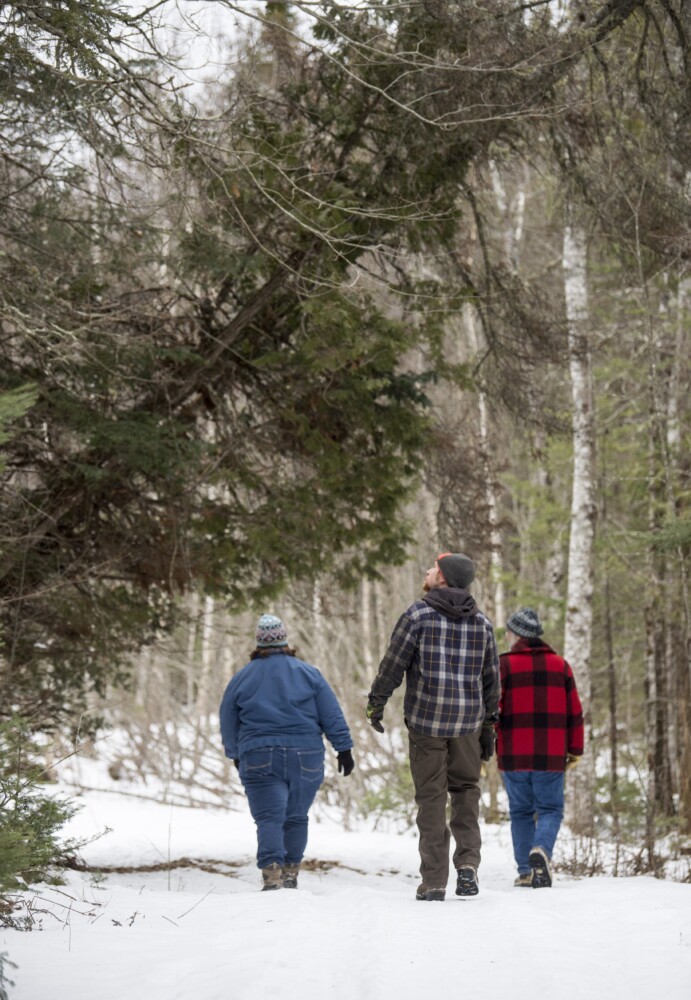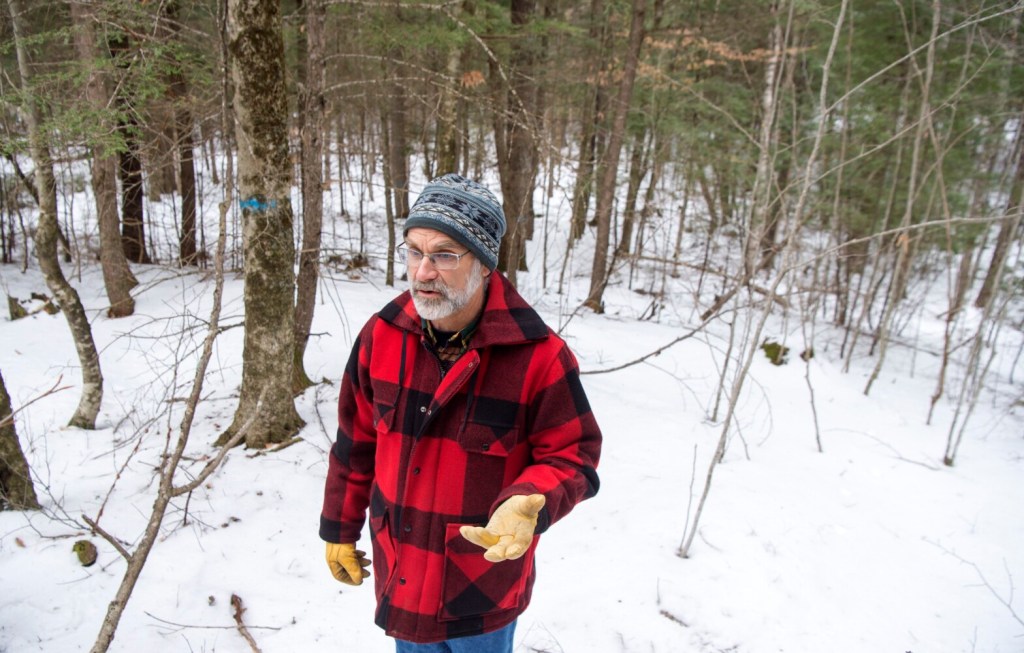CHINA — The town-owned forest will be harvested for the first time in 22 years next week, officials said.
During a Saturday morning tour of the 60-acre property tucked behind China Primary School, forester Harold Burnett pointed out trees — fir, hemlock, beech, spruce, white birch, white ash and white pine — marked with bright blue paint and ties. Those are the ones that will be cut down by China logger Tyler Reynolds when the harvest begins in the second week of February.

Burnett and Reynolds — along with volunteer forest stewards Anita Smith and Elaine Philbrook, and coordinator of the Maine Tree Farm Program Logan Johnson — hosted two public information sessions on the management plan Saturday, the first at 10 a.m. at the town office portable building and the second on the trails at 11 a.m. Though there was only a modest turnout. Burnett said he views that as a positive, a sign that few members of the community are concerned about the process.
The China School Forest is one of 250 tree farms in Kennebec County, and one of 1,400 in the state, according to Johnson. The forest is primarily used to teach schoolchildren about silviculture, which, as Smith said, is “the art and science of managing forests for desired outcomes.” In this case, those desired outcomes are both educational and commercial — wood products from harvests generate revenue that Smith and Philbrook hope to put back into the management of the forest and features that make it more accessible.
The forest, which contains about 2 miles of trails open to the public, already has several spaces for outdoor learning, including a pavilion with picnic tables, a large tree house built around the trunk of an eastern white pine and a fallen tree-turned couch, thanks to the help of a local parent and his chainsaw. On the wish list right now is a heated outdoor hut that could double as a classroom and a winter storage space for the signs and activities for roughly 20 educational stations around the forest. Smith and Philbrook, former teachers in the China school system, currently keep those items in their own houses until spring rolls around.
The eastern-most 20 acres of the forest are the target for this year’s harvest, primarily because that area has the fewest high-value species of tree, which the harvest hopes to change. Primarily, mature and over-mature fir will be removed to create small patch openings and enable white birch, red maple and some white pine to grow, according to Smith. Hemlock, beech and scattered white birch and white ash will also be cut to allow smaller hemlock, scattered red maple, sugar maple and yellow birch to grow. Other species may also be removed to promote growth of other trees.

Harold Burnett, with Two Trees Forestry, gives a tour Saturday of the China woods to logger Tyler Reynolds, center, and Anita Smith, left. Foresters and local volunteers presented the public with its plan to harvest the China School’s Forest, one of 250 certified tree farms in Kennebec County, for the first time in 22 years Saturday. Morning Sentinel photo by Michael G. Seamans
“The focus on this entire harvest is to remove the poorest and let the best get bigger and bigger,” Burnett explained Saturday.
The cut wood will be sold as lumber, firewood and pulp, with the pulpwood going mostly to the Verso paper mill in Jay and logs going to concentration yards that will send out the lumber by type to various mills across the state, Burnett said. Pine sawmills in Belgrade and Pittsfield will likely get shipments from the harvest as well, Burnett and Reynolds said.
“This initial harvest would likely yield 10,000 to 15,000 board feet of sawtimber and 150 to 200 cords of pulpwood, worth $6,000 to $8,000,” according to the China School Forest harvest plan, dated October 2019.
Spruce and fir are mostly used for creating two-by-fours, two-by-sixes and two-by-eights that are used to create the frames of various structures, according to Burnett. White pine is generally sawed to 1 inch thick and used for door frames and trim, while hemlock tends to be used for beams. Hardwood gets used mostly for furniture and flooring.
The China School Forest was last harvested in 1998, following a heavy ice storm that damaged the forest. In the two decades since, the trees were largely left alone so they could recover. While Smith was hoping to set a once-every-five-years harvest cycle, Burnett said harvests will happen every seven years, rotating between different thirds of the property and giving each individual section 21 years to grow between harvests. That will still allow China schoolchildren to witness at least one harvest during their time in the primary and middle schools.
Smith said that to engage the children with the harvest this year, they will visit the forest and either watch Reynolds cut and de-limb trees or, if liability reasons prevent that from being possible, they will learn about the machinery and why certain trees are being cut and others are not.
The China School Forest was first certified as a tree farm in 1985, according to Johnson. Tree farms in Maine must have management plans and are governed by the American Forest Foundation’s standards of sustainability, according to the Maine Forest Service.
Send questions/comments to the editors.









Comments are no longer available on this story